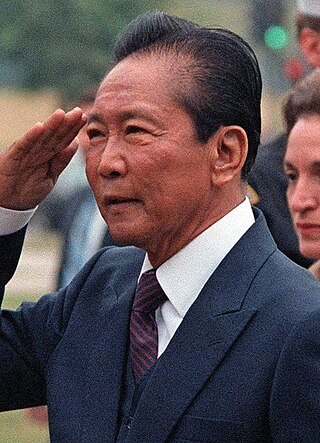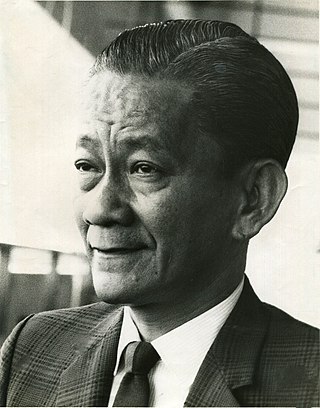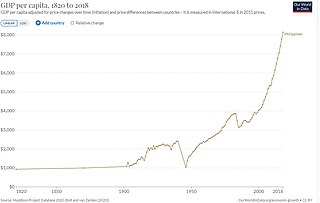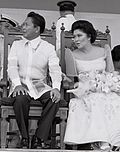
Ferdinand Emmanuel Edralin Marcos Sr. was a Filipino lawyer, politician, dictator and kleptocrat who served as the tenth president of the Philippines from 1965 to 1986. Marcos ruled the country under martial law from 1972 to 1981, and with vastly expanded powers under the 1973 Constitution until he was deposed by a nonviolent revolution in 1986. Marcos described his rule's philosophy as "constitutional authoritarianism" under his Kilusang Bagong Lipunan. One of the most controversial figures in Filipino history, Marcos's regime was infamous for its corruption, extravagance, and brutality.
Structural adjustment programs (SAPs) consist of loans provided by the International Monetary Fund (IMF) and the World Bank (WB) to countries that experience economic crises. Their stated purpose is to adjust the country's economic structure, improve international competitiveness, and restore its balance of payments.

Sergio "Serging" Veloso Osmeña Jr. was a Filipino politician who served as a Senator of the Philippines, and ran against Ferdinand Marcos in the 1969 Philippine Presidential election. He was the son of Sergio Osmeña, the fourth president of the Philippines. His son, Sergio Osmeña III, was also a Senator of the Philippines.

The Latin American debt crisis was a financial crisis that originated in the early 1980s, often known as La Década Perdida, when Latin American countries reached a point where their foreign debt exceeded their earning power, and they could not repay it.
The First Quarter Storm, often shortened into the acronym FQS, was a period of civil unrest in the Philippines which took place during the "first quarter of the year 1970". It included a series of demonstrations, protests, and marches against the administration of President Ferdinand Marcos, mostly organized by students and supported by workers, peasants, and members of the urban poor, from January 26 to March 17, 1970. Protesters at these events raised issues related to social problems, authoritarianism, alleged election fraud, and corruption at the hand of Marcos.

Overseas Filipino Worker (OFW) is a term often used to refer to Filipino migrant workers, people with Filipino citizenship who reside in another country for a limited period of employment. The number of these workers was roughly 1.77 million between April and September 2020. Of these, female workers comprised a larger portion, making up 59.6 percent, or 1.06 million. However, this number declined to 405.62 thousand between 2019 and 2020.

The history of the Philippines, from 1965 to 1986, covers the presidency of Ferdinand Marcos. The Marcos era includes the final years of the Third Republic (1965–1972), the Philippines under martial law (1972–1981), and the majority of the Fourth Republic (1981–1986). By the end of the Marcos dictatorial era, the country was experiencing a debt crisis, extreme poverty, and severe underemployment.

The Fourth Philippine Republic, also known as the FourthRepublic of the Philippines, was established after Ferdinand Marcos won the 1981 Philippine presidential election and referendum. Marcos announced the beginning of the Fourth Republic on June 30, during his inauguration speech. On February 25, 1986, due to the People Power Revolution, Marcos went into exile in Hawaii, and Corazon Aquino became the 11th president of the Philippines. The Fourth Republic would come to an end under Aquino's leadership, and the Fifth Republic would commence with the adoption of a new constitution.

Martial law in the Philippines refers to the various historical instances in which the Philippine head of state placed all or part of the country under military control—most prominently during the administration of Ferdinand Marcos, but also during the Philippines' colonial period, during the second world war, and more recently on the island of Mindanao during the administrations of Gloria Macapagal Arroyo and Rodrigo Duterte. The alternative term "martial law era" as applied to the Philippines is typically used to describe the Marcos martial law period specifically.

The economic history of the Philippines is shaped by its colonial past, evolving governance, and integration into the global economy.
Student activism in the Philippines from 1965 to 1972 played a key role in the events which led to Ferdinand Marcos' declaration of Martial Law in 1972, and the Marcos regime's eventual downfall during the events of the People Power Revolution of 1986.
El Salvador has been a member of the International Monetary Fund (IMF) since 1946. Their quota currently consists of 287.20 million SDR. The country has received loans from the IMF in the past, but most recently has received only standby loans and currently has no outstanding payments. As of June 2017, the standby arrangements total 1,442,300 SDR while the government has only drawn upon 132,250 SDR.

At 7:15 p.m. on September 23, 1972, President Ferdinand Marcos announced on television that he had placed the Philippines under martial law, stating he had done so in response to the "communist threat" posed by the newly founded Communist Party of the Philippines (CPP), and the sectarian "rebellion" of the Muslim Independence Movement (MIM). Opposition figures of the time accused Marcos of exaggerating these threats and using them as an excuse to consolidate power and extend his tenure beyond the two presidential terms allowed by the 1935 constitution. Marcos signed Proclamation No. 1081 on September 21, 1972, marking the beginning of a fourteen-year period of one-man rule, which effectively lasted until Marcos was exiled from the country on February 25, 1986. Proclamation No. 1081 was formally lifted on January 17, 1981, although Marcos retained essentially all of his powers as dictator until he was ousted in February 1986.

Ferdinand Marcos was inaugurated to his first term as the 10th president of the Philippines on December 30, 1965. His inauguration marked the beginning of his two-decade long stay in power, even though the 1935 Philippine Constitution had set a limit of only two four-year terms of office. Marcos had won the Philippine presidential election of 1965 against the incumbent president, Diosdado Macapagal.
The 1969 reelection campaign of Ferdinand Marcos, the 10th president of the Philippines, started in July 1969 when incumbent President Ferdinand Marcos was unanimously nominated as the presidential candidate of the Nacionalista Party, and concluded when the 1969 Philippine presidential election concluded with Marcos winning an unprecedented second full term as President of the Philippines. With Fernando Lopez as his vice president, he ran against the Liberal Party slate of Sergio Osmeña Jr., and Genaro Magsaysay.

The 21-year period of Philippine economic history during Ferdinand Marcos’ regime – from his election in 1965 until he was ousted by the People Power Revolution in 1986 – was a period of significant economic lows.

Ferdinand Marcos's second term as President of the Philippines began on December 30, 1969, as a result of his winning the 1969 Philippine presidential election on November 11, 1969. Marcos was the first and last president of the Third Philippine Republic to win a second full term. The inauguration was at the Quirino Grandstand in Manila. The inauguration marked the commencement of the second four-year term of Ferdinand Marcos as president and the third term of Fernando Lopez as Vice President. The oath of office was administered by Chief Justice of the Supreme Court of the Philippines Roberto Concepcion.

Bolivia joined the IMF on December 27, 1945. Since 1945, Bolivia has cooperated with the IMF to achieve social reforms and economic growth. These efforts have involved strategies to reduce poverty, increase social equity, improve the education system and healthcare system, and expand social services to rural populations and underserved urban communities. Since 1984, Bolivia has been an active client of the fund, accessing 19 credit lines with the fund since joining.
The alleged September 22, 1972, ambush attack on the then-Defense Minister of the Philippines Juan Ponce Enrile is a disputed incident in which Enrile's white Mercedes-Benz sedan was ambushed near the upscale Wack Wack village in Mandaluyong, Metro Manila. It was cited by President Ferdinand Marcos as the proximate incident which led to the announcement of Marcos' declaration of martial law the following day, although Marcos would later claim that he signed the formal proclamation of martial law on September 21, the day before the Enrile ambush.














